GHS Classification Criteria in A Single Page
Little Pro on 2016-05-09Views: 25520 Update:2018-10-17
GHS classification criteria are used to determine the nature and the relative severity of the hazard of a chemical substance or mixture. In this article, we have summarized GHS classification criteria (in GHS rev. 6) for all 29 hazard classes, including 17 physical hazards, 10 health hazards and 2 environmental hazards (see all GHS hazard classes).
For a substance, you can refer to the table below to determine its GHS classification. For a mixture, it is recommended that you read this article (GHS mixture classification) first.
It should be noted that GHS allows each country to choose their own concentration limits for certain hazard categories. The classification criteria below works for most of countries, but not all countries.
Note: If you wish to quickly search a hazard statement and signal word based on GHS hazard classification and H code, please go to our free hazard statement and signal word finder.
Explosives
Explosives can be classified as unstable explosives or stable explosives. For stable explosives, there are 6 divisions under GHS (see the table below).
| Division | Characteristics |
|---|---|
| 1.1 | Mass explosion hazard |
| 1.2 | Projection hazard |
| 1.3 | Fire hazard or minor projection hazard |
| 1.4 | No significant hazard |
| 1.5 | Very insensitive substances with mass explosion hazard |
| 1.6 | Extremely insensitive substances with no mass explosion hazard |
Classification as an explosive and allocation to a division is a three-step process
- Ascertain if the material has explosive effects (Test Series 1 of UN TDG);
- Acceptance procedure (Test Series 2 to 4 of TDG);
- Assignment to one of six hazard divisions (Test Series 5 to 7 of UN TDG).
Explosive properties are usually associated with certain chemical groups (see picture below) that can react to give very rapid increases in temperature or pressure. GHS allows you to classify a substance as non-explosive if there are no functional groups associated with explosive properties in the molecule. If a substance is identified to be a potential explosive, acceptance procedure/testing must be followed to determine right division.
Flammable Gases (Including Unstable Gases)
The table below summarizes GHS classification criteria for flammable gases (including pyrophoric gases and chemically unstable gases).
| Type | Category | GHS Classification Criteria |
|---|---|---|
| Flammable gases | Category 1 | Gases, which at 20°C (68°F) and a standard pressure of 101.3 kPa (14.7 psi) that: (a) are ignitable when in a mixture of 13% or less by volume in air; or (b) have a flammable range with air of at least 12 percentage points regardless of the lower flammable limit. |
| Flammable gases | Category 2 | Gases, other than those of Category 1, which, at 20°C (68°F) and a standard pressure of 101.3 kPa (14.7 psi), have a flammable range while mixed in air. |
| Pyrophoric gases | Category 1 | Flammable gases that ignite spontaneously in air at a temperature of 54°C or below |
| Chemically unstable gases | Category A | Flammable gases, which are chemically unstable at 20°C (68°F) and a standard pressure of 101.3 kPa |
| Chemically unstable gases | Category B | Flammable gases, which are chemically unstable at a temperature higher than 20°C (68°F) or a pressure greater than 101.3 kPa |
Aerosols
Aerosols are any gas compressed, liquefied or dissolved under pressure within a non-refillable container made of metal, glass or plastic, with or without a liquid, paste or powder. Aerosols should be considered for classification as either a Category 1 or Category 2 Flammable Aerosol if they contain any component classified as flammable according to the GHS criteria for flammable liquids, flammable gases, or flammable solids.
| Type | Category | GHS Classification Criteria |
|---|---|---|
| Aerosols | Category 3 | The concentration of the flammable components ≤ 1% and the heat of combustion is < 20 kJ/g or other spray/foam aerosols. |
| Aerosols | Category 1 | The concentration of the flammable components >85% and the heat of combustion is ≥ 30 kJ/g. |
| Spray Aerosols | Category 1 | Ignition occurs at a distance >=75cm in an ignition test. |
| Spray Aerosols | Category 2 | Ignition occurs at a distance <75cm in an ignition test. However, the heat of combustion is >20kJ/g or ignition distance is >=15cm or the space ignition test shows that the time equivalent <=300s/m3 or the deflation density <300g/m3; |
| Foam Aerosols | Category 1 | In the foam test, the flame height is >=20cm and the flame duration >=2s; or the flame height is >=4cm and the flame duration >=7s. |
| Foam Aerosols | Category 2 | In the foam test, the flame height is >=4cm and the flame duration >=2s. |
Oxidizing Gases
| Category | GHS Classification Criteria |
|---|---|
| Category 1 | Gases that cause or contribute to the combustion of other material more than air does. Usually test is not needed. Calculation of oxidizing power can be done according to ISO 10156:2012. |
Gases Under Pressure
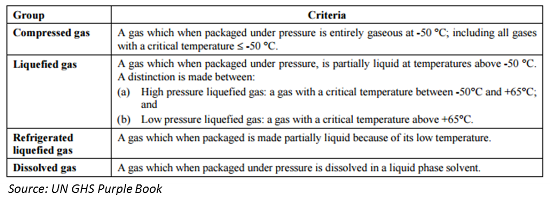
Flammable Liquids

Flammable Solids
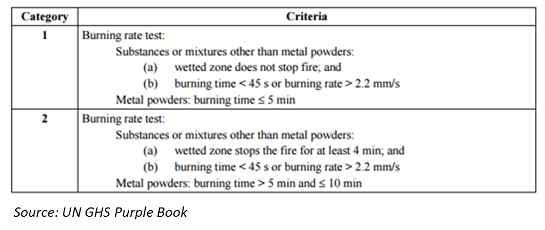
Self-reactive Substances
| Type | GHS Classification Criteria |
|---|---|
| A | Any self-reactive substance or mixture which can detonate or deflagrate rapidly, as packaged; |
| B | Any self-reactive substance or mixture possessing explosive properties and which, as packaged, neither detonates nor deflagrates rapidly, but is liable to undergo a thermal explosion in that package; |
| C | Self-reactive substance or mixture possessing explosive properties when the substance or mixture as packaged cannot detonate or deflagrate rapidly or undergo a thermal explosion; |
| D | Self-reactive substance or mixture which in laboratory testing either detonates partially, does not deflagrate rapidly and shows no violent effect when heated under confinement; does not detonate at all, deflagrates slowly and shows no violent effect when heated under confinement; or does not detonate or deflagrate at all and shows a medium effect when heated under confinement; |
| E | Self-reactive substance or mixture which, in laboratory testing, neither detonates nor deflagrates at all and shows low or no effect when heated under confinement; |
| F | Self-reactive substance or mixture which, in laboratory testing, neither detonates in the cavitated state nor deflagrates at all and shows only a low or no effect when heated under confinement; |
| G | Self-reactive substance or mixture which, in laboratory testing, neither detonates in the cavitated state nor deflagrates at all and shows no effect when heated under confinement and no explosive powder, provided that it is thermally stable and, for liquid mixtures, a diluent having a boiling point greater than or equal to 150°C is used for desensitization; |
Pyrophoric Solids
| Category | GHS Classification Criteria |
|---|---|
| Category 1 | The solid ignites within 5 mins of coming into contact with air. |
Pyrophoric Liquids
| Category | GHS Classification Criteria |
|---|---|
| Category 1 | The liquid ignites within 5 mins when added to an inert carrier or exposed to air, or it ignites or chars a filter paper on contact with air within 5 mins. |
Self-heating Substances and Mixtures
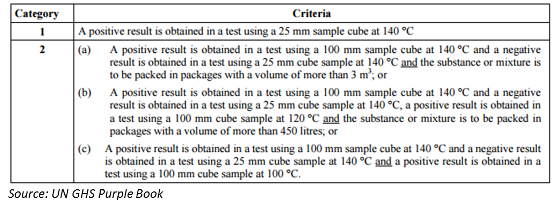
Substances which on Contact with Water Emit Flammable Gases
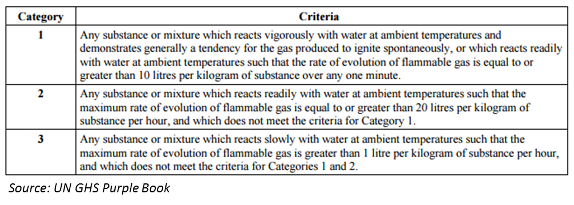
Oxidizing Liquids
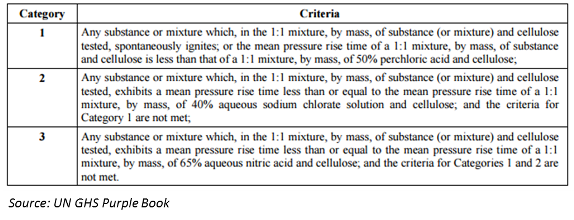
It shall be noted that above ignition test is not necessary to determine whether or not a substance or mixture is oxidizing; examination of its structural formula may provide predictive information. Organic peroxides, for instance, are generally considered as oxidizing. However, the following substances are not considered as oxidizing:
- Organic substance or mixture that does not contain oxygen, flourine or chlorine; or
- The substance or mixture contains oxygen, flourine or chlorine and there elements are bonded only to hydrogen or carbon;
- Inorganic substances that do not contain oxygen or halogen items.
Oxidizing Solids
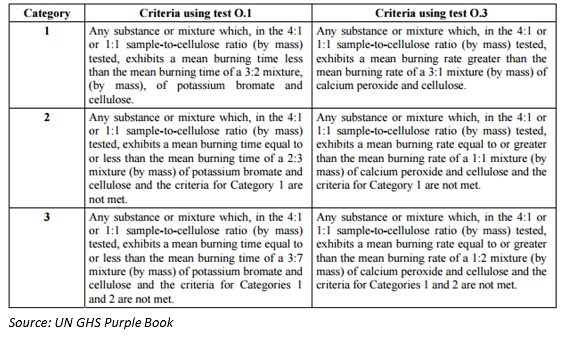
It shall be noted that above ignition test is not necessary to determine whether or not a substance or mixture is oxidizing; examination of its structural formula may provide predictive information. Organic peroxides, for instance, are generally considered as oxidizing. However, the following substances are not considered as oxidizing:
- Organic substance or mixture that does not contain oxygen, flourine or chlorine; or
- The substance or mixture contains oxygen, flourine or chlorine and there elements are bonded only to hydrogen or carbon;
- Inorganic substances that do not contain oxygen or halogen items.
Organic Peroxides
| Type | GHS Classification Criteria |
|---|---|
| A | Any organic peroxide which, as packaged, can detonate or deflagrate rapidly. |
| B | Any organic peroxide possessing explosive properties and which, as packaged, neither detonates nor deflagrates rapidly, but is liable to undergo a thermal explosion in that package. |
| C | Any organic peroxide possessing explosive properties when the substance or mixture as packaged cannot detonate or deflagrate rapidly or undergo a thermal explosion; |
| D | Any organic peroxide which in laboratory testing:
|
| E | Any organic peroxide which, in laboratory testing, neither detonates nor deflagrates at all and shows low or no effect when heated under confinement. |
| F | Any organic peroxide which, in laboratory testing, neither detonates in the cavitated state nor deflagrates at all and shows only a low or no effect when heated under confinement as well as low or no explosive power. |
| G | Any organic peroxide which, in laboratory testing, neither detonates in the cavitated state nor deflagrates at all and shows no effect when heated under confinement nor any explosive power, provided that it is thermally stable (self-accelerating decomposition temperature is 60°C or higher for a 50 kg package). |
Corrosive to Metals
| Category | GHS Classification Criteria |
|---|---|
| Category 1 | Corrosion rate on steel or aluminum surfaces exceeds 6.25 mm per year at a test temperature of 55°C. |
Desensitized Explosives

Acute Toxicity
Substances are assigned to one of the five toxicity categories on the basis of LD50 (oral, dermal) or LC50 (inhalation).from acute toxicity studies. Some countries/region (i.e, EU) have not adopted acute toxicity category 5.
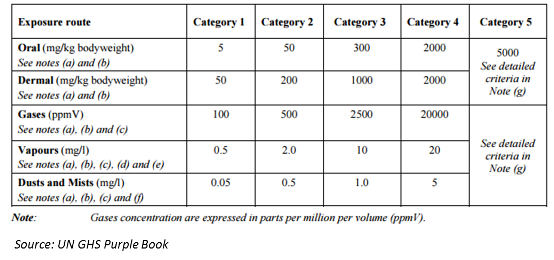
Skin Irritation/Corrosion
| Category | Classification Criteria |
|---|---|
Category 1 Corrosive
|
|
Category 2 Irritant
|
|
Category 3 Mild Irritant
|
|
More info about GHS classification criteria for skin irritation can be found here.
Serious Eye Damage/Eye Irritation
| Category | GHS Classification Criteria |
|---|---|
Category 1 (Causes serious eye damage)
|
|
Category 2A (Irritant)
|
|
Category 2B (Mild irritant)
|
|
More info about GHS classification criteria for eye irritation can be found here.
Respiratory or Skin Sensitization
| Category 1 Skin Sensitization | Category 1 Respiratory Sensitization |
|---|---|
For substances and tested mixtures:
• If there is evidence in humans that the individual substance can induce sensitization by skin contact in a substantial number of persons, or where there are positive results from an appropriate animal test.
• If any individual skin sensitizer in the mixture has a concentration of: Subcategory 1B≥ 1.0% Solid/Liquid/Gas or Subcategory 1A≥ 0.1% Solid/Liquid/Gas
|
For substances and tested mixtures:
• If there is human evidence that the individual substance induces specific respiratory hypersensitivity, and/or Where there are positive results from an appropriate animal test.
• If any individual respiratory sensitizer in the mixture has a concentration of: ≥ 1.0% Solid/Liquid and ≥ 0.2% Gas
|
Germ Cell Mutagenicity
| Category | Criteria |
|---|---|
| Category 1A | Chemicals known to induce or regarded as if they induce heritable mutations in human germ cells
Known to induce heritable mutations –positive evidence from human epidemiological studies.
Mixtures containing ≥ 0.1% of such a category 1A mutagen.
|
| Category 1B | Chemicals known to induce or regarded as if they induce heritable mutations in human germ cells
Regard as if they induce heritable mutations – positive results from in vivo heritable germ cell or somatic cell mammalian mutagenicity tests, or positive results showing mutagenic effects in the germ cells of humans without demonstration of transmission to progeny.
Mixtures containing ≥ 0.1% of such a category 1B mutagen.
|
| Category 2 | Chemicals that may induce heritable mutations in human germ cells
Positive evidence obtained from in vivo somatic cell mutagenicity or somatic cell genotoxicity tests in mammals and in some cases with support from in vitro experiments
Mixtures containing ≥ 1% of such a category 2 mutagen.
|
More info about GHS classification criteria for germ cell mutagenicity can be found here.
Carcinogenicity
| Category | Criteria |
|---|---|
| Category 1A | Chemicals known to have carcinogenic potential to humans - largely based on human evidence
Mixtures containing ≥ 0.1% of such a category 1A carcinogen.
|
| Category 1B | Chemicals presumed to have carcinogenic potential to humans - largely based on animal evidence.
Mixtures containing ≥ 0.1% of such a category 1B carcinogen.
|
| Category 2 | Suspected human carcinogen - evidence from human and/or animal studies is limited
Mixtures containing ≥ 0.1% of such a category 2 carcinogen. (Note: Some countries have different concentration limits. For example, EU's concentration limit for category 2 carcinogen is 1%).
|
Reproductive Toxicity
| Category | Criteria |
|---|---|
| Category 1A | Known human reproductive toxicants
Mixtures containing ≥ 0.1% or ≥ 0.3 % of such a substance. (EU's value is 0.3%).
|
| Category 1B | Presumed human reproductive toxicants - largly based on animal studies
Mixtures containing ≥ 0.1% or ≥ 0.3 % of such a substance. (EU's value is 0.3%. USA's value is 0.1%)
|
| Category 2 | Suspected human reproductive toxicant - Evidence from animal and/or human studies is limited
Mixtures containing ≥ 0.1% or ≥ 3 % of such a substance. (EU's value is 3% while USA's value is 0.1%).
|
| Effects on via lactation | Effects on via lactation
Toxicants which may interfere with lactation or which may be present in breast milk and may cause harm to breast-fed children
Mixtures containing ≥ 0.1% or ≥ 0.3 % of such a substance.
|
Target Organ Systemic Toxicity - Single Exposure
This provide a means of classifying substances that produce specific, non lethal target organ/systemic toxicity arising from a single exposure. Guidance value from acute toxicity studies are used to determine specific hazard category.

For mixture, please refer to the table below:

Target Organ Systemic Toxicity - Repeated Exposure
This provides a means of classifying substances that produce specific target organ/systemic toxicity arising from repeated exposure that is not specifically addressed elsewhere in the harmonised classification system (GHS).
Standard 90d repeated dose toxicity study serves as the most important study to determine the classification of the specific target organ toxicity of a chemical substance. Since toxicity depends on doses, GHS uses guidance value C to determine the hazard category of specific target organ/systemic toxicity. Guidance value C is defined as test concentration at which there is evidence of significant toxicity and it is not NOAEL. Guidance value C is usually bigger than NOAEL. Some effects such as body weight change are not regarded as significant toxicity.
Repeated dose toxicity studies of greater or lesser duration can be used to derive equivalent guidance value by extrapolation.
| Category | Classification Criteria and Guidance Value |
|---|---|
| Category 1 |
Reliable evidence on the substance or mixture (including bridging) of an adverse effect on specific organ/systems or systemic toxicity in humans or animals. May be named for specific organ/system.
For tested substances and mixtures:
Mixture that lacks sufficient data, but contains Category 1 ingredient: ≥ 1 to ≤ 10% for some authorities; and ≥ 10% for all authorities.
|
| Category 2 |
Evidence on the substance or mixture (including bridging) of an adverse effect on specific organ/systems or systemic toxicity from animal studies or humans. May be named for specific organ/system.
For substances and tested mixtures:
Mixture that lacks sufficient data, but contains Category 1 ingredient: ≥ 1.0 but ≤ 10% for some authorities and/or contains Category 2 ingredient: ≥ 1.0 or ≥ 10%.
|
Aspiration Toxicity
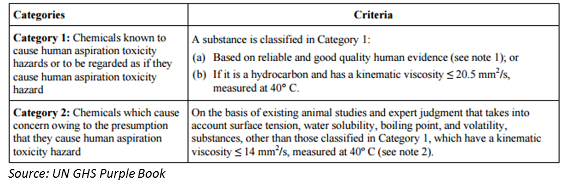
For mixture, please refer to the table below:
| Category | Criteria |
|---|---|
| Category 1 |
Contains >=10% category 1 ingredient and has a kinematic viscosity<=20.5mm2/s (measured at 40 celcius degrees);
|
| Category 2 | Contains >=10% category 2 ingredient and has a kinematic viscosity<=14mm2/s (measured at 40 celcius degrees); |
Hazardous to Aquatic Environment (Acute/Chronic)
The picture below summarizes environmental hazard classification based on aquatic toxicity data. Lower LC50/EC50/NOEC indicates higher toxicity. Please note that degradation and bio-concentration shall also be taken into account.
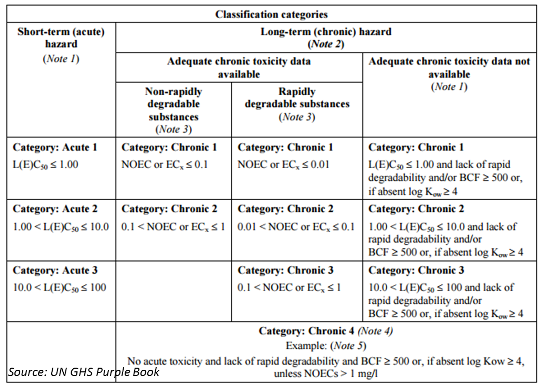
For mixture, please refer to the table below. If you do not know what M-factor is and how it is used for environmental hazard classification, please click here.
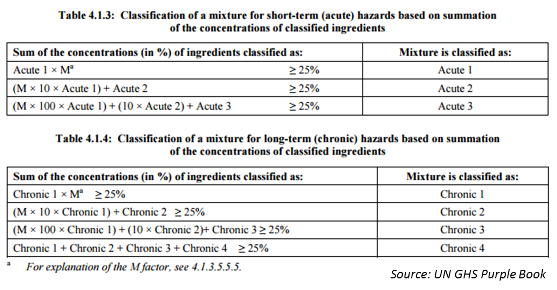
The value of multiplying factor (M-factor) can be found in the table below:
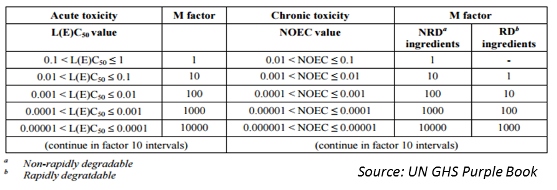
Hazardous to the Ozone Layer
| Category | Criteria |
|---|---|
| Category 1 |
Any of the controlled substances in the annexes to the Montreal Protocol; or any mixture containing at least 1 ingredient listed in the annexes to the Montreal protocal, at a concentration>=0.1%;
|
No comments:
Post a Comment